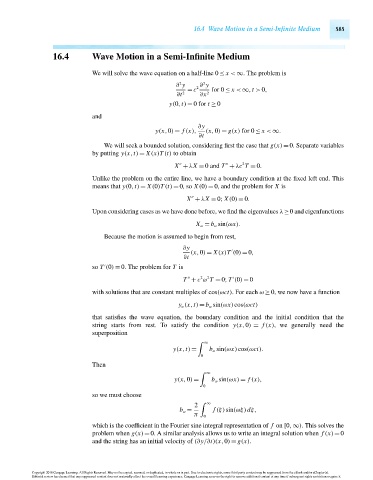Page 605 - Advanced_Engineering_Mathematics o'neil
P. 605
16.4 Wave Motion in a Semi-Infinite Medium 585
16.4 Wave Motion in a Semi-Infinite Medium
We will solve the wave equation on a half-line 0 ≤ x < ∞. The problem is
2
2
∂ y ∂ y
= c 2 for 0 ≤ x < ∞,t > 0,
∂t 2 ∂x 2
y(0,t) = 0for t ≥ 0
and
∂y
y(x,0) = f (x), (x,0) = g(x) for 0 ≤ x < ∞.
∂t
We will seek a bounded solution, considering first the case that g(x) = 0. Separate variables
by putting y(x,t) = X(x)T (t) to obtain
2
X + λX = 0 and T + λc T = 0.
Unlike the problem on the entire line, we have a boundary condition at the fixed left end. This
means that y(0,t) = X(0)T (t) = 0, so X(0) = 0, and the problem for X is
X + λX = 0; X(0) = 0.
Upon considering cases as we have done before, we find the eigenvalues λ≥0 and eigenfunctions
X ω = b ω sin(ωx).
Because the motion is assumed to begin from rest,
∂y
(x,0) = X(x)T (0) = 0,
∂t
so T (0) = 0. The problem for T is
2
2
T + c ω T = 0; T (0) = 0
with solutions that are constant multiples of cos(ωct). For each ω ≥ 0, we now have a function
y ω (x,t) = b ω sin(ωx)cos(ωct)
that satisfies the wave equation, the boundary condition and the initial condition that the
string starts from rest. To satisfy the condition y(x,0) = f (x), we generally need the
superposition
∞
y(x,t) = b ω sin(ωx)cos(ωct).
0
Then
∞
y(x,0) = b ω sin(ωx) = f (x),
0
so we must choose
2 ∞
b ω = f (ξ)sin(ωξ)dξ,
π 0
which is the coefficient in the Fourier sine integral representation of f on [0,∞). This solves the
problem when g(x)=0. A similar analysis allows us to write an integral solution when f (x)=0
and the string has an initial velocity of (∂y/∂t)(x,0) = g(x).
Copyright 2010 Cengage Learning. All Rights Reserved. May not be copied, scanned, or duplicated, in whole or in part. Due to electronic rights, some third party content may be suppressed from the eBook and/or eChapter(s).
Editorial review has deemed that any suppressed content does not materially affect the overall learning experience. Cengage Learning reserves the right to remove additional content at any time if subsequent rights restrictions require it.
October 14, 2010 15:23 THM/NEIL Page-585 27410_16_ch16_p563-610

